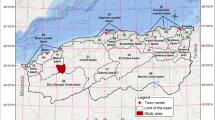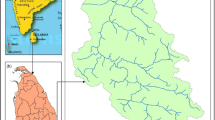Abstract
In China, many scenic and tourism areas are suffering from the urbanization that results from physical development of tourism projects, leading to the removal of the vegetative cover, the creation of areas impermeable to water, in-stream modifications, and other problems. In this paper, the risk of soil erosion and its ecological risks in the West Lake Scenic Spots (WLSS) area were quantitatively evaluated by integrating the revised universal soil loss equation (RUSLE) with a digital elevation model (DEM) and geographical information system (GIS) software. The standard RUSLE factors were modified to account for local climatic and topographic characteristics reflected in the DEM maps, and for the soil types and vegetation cover types. An interface was created between the Arcinfo software and RUSLE so that the level of soil erosion and its ecological risk in the WLSS area could be mapped immediately once the model factors were defined for the area. The results from an analysis using the Arcinfo-RUSLE interface showed that the risk value in 93 % of the expanding western part of the WLSS area was moderate or more severe and the soil erosion risk in this area was thus large compared with that in the rest of the area. This paper mainly aimed to increase the awareness of the soil erosion risk in urbanizing areas and suggest that the local governments should consider the probable ecological risk resulting from soil erosion when enlarging and developing tourism areas.
Similar content being viewed by others
References
Chariat, S., Delleur, J.W., 1993. Integrating a physically based hydrological model with GRASS. In: Kovar, K. (ed). Application of GIS in Hydrology and Water Resources Management. Wallingford IAHS press, pp. 143–150.
Eastman, R.J., 1997. IDRISI for Windows: User’s Guide, Version 2.0, Chaps. 4–17. Clark Labs for Cartographic Technology and Geographical Analysis, Worcester.
Environmental Systems Research Institute (ESRI). Inc., Cell Base Modeling with Grid. Redlands.CA:[s.n.],1992.
Foster, G.R., Wischmeier, W.H., 1974. Evaluating irregular slopes for soil loss prediction. Transactions of the American Society of Agricultural Engineers, 172, 305–309.
HHS (Hangzhou Hydrology Station), 2000. Rainfall data monthly amounts for 30 years. Hangzhou, China (In Chinese, with English summary).
Jiang, Z.S, Zeng F.L. 2004. Water erosion prediction models a t hill slope scale. Journal of Soil and Water Conservation. 18(1):56–70 (In Chinese, with English summary).
LMBZP (Land Management Bureau of Zhejiang Province), 1984. A hardcopy of a 1:10,000 soil type maps in WLSS. Hangzhou.
Lu, X.X, Shen, R.M., 1992. A preliminary study on the value K of soil erosibility factor. Journal of Soil and Water Conservation 6(1),63–70. (In Chinese, with English summary).
MWRPRC (Ministry of Water Resources of the People’s Republic of China), 1997. Classification standard of soil erosion (SL190-96). China Waterpower Press, Beijing (In Chinese, with English summary).
Nearing, M.A., 1997. A single, continuous function for slope steepness influence on soil loss. Soil Science Society of America Journal, 61(3), 917–919.
Renard, K.G., Freimund, J.R., 1994. Using monthly precipitation data to estimate the R factor in the revised USLE. Journal of Hydrology 157(1–4), 287–306.
Renard, K.G., Foster, G.R., Weesies, G.A., McCool, D.K., Yoder, D.C., 1997. Predicting soil erosion by water: a guide to conservation planning with the Revised Universal Soil Loss Equation RUSLE. Handbook 703. U.S. Department of Agriculture, Washington DC, USA.
Shao Yaoming. 2006. The design of Rain-storm strength information system based on GIS techniques. Urban Geotechnical Investigation & Surveying, 3, 24–26 (In Chinese, with English summary).
SBZP (Surveying Bureau of Zhejiang Province), 1997. A hardcopy of 1:5,000 topographic maps in WLSS. Hangzhou, China.
Shi, Z.H., Cai, C.F., Ding, S.W., Wang, T.W., Chow, T.L. 2004. Soil conservation planning at the small watershed level using RUSLE with GIS: a case study in the Three Gorge Area of China. Catena 55(1), 33–48.
Sukopp, H, 2004. Human-caused impact on preserved vegetation. Landscape and Urban Planning, 68, 347–355.
SSOZP (The Soil Survey Office of Zhejiang Province), 1994. The Soils of Zhejiang. Zhejiang Science and Technology Press, Hangzhou. China.
Wischmeier, W.H., Smith, D.D., 1978. Predicting Rainfall Erosion Losses —A Guide to Conservation, Agricultural Handbook 537. Planning, Science and Education Administration. U.S. Department of Agriculture, Washington, DC.
Wang, G.X., Gertner, G., Liu, X.Z., Anderson, A., 2001. Uncertainty assessment of soil erodibility factor for revised universal soil loss equation. Catena 46, 1–14.
ZFSI (Zhejiang Forest Surveying Insitute), 2000. A digitized forest types map of Xihu District, Hangzhou. Department of Urban Planning, Hangzhou, China.
Zhou, F.J., Huang, Y.H., Chen, M.H., 1995. The rainfall erosivity index in Fujian province. Journal of Soil and Water Conservation 9(1), 13–18. (In Chinese, with English summary)
Author information
Authors and Affiliations
Corresponding author
Rights and permissions
About this article
Cite this article
Wang, W. Managing soil erosion potential by integrating digital elevation models with the southern China’s revised universal soil loss equation. J. Mt. Sci. 4, 237–247 (2007). https://doi.org/10.1007/s11629-007-0237-7
Received:
Accepted:
Issue Date:
DOI: https://doi.org/10.1007/s11629-007-0237-7




